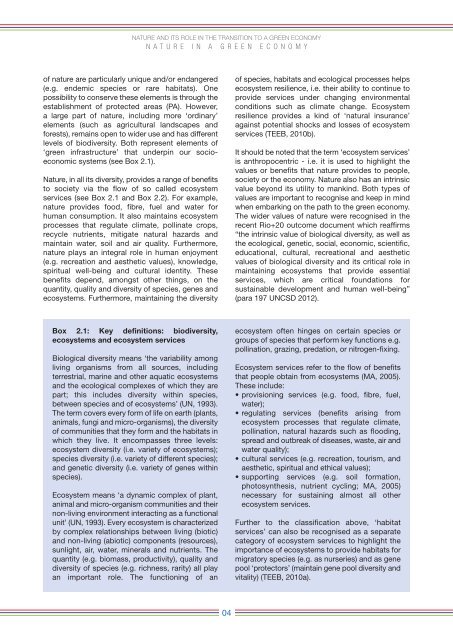Green-Economy-Report
Green-Economy-Report
Green-Economy-Report
You also want an ePaper? Increase the reach of your titles
YUMPU automatically turns print PDFs into web optimized ePapers that Google loves.
NATURE AND ITS ROLE IN THE TRANSITION TO A GREEN ECONOMY<br />
N A T U R E I N A G R E E N E C O N O M Y<br />
of nature are particularly unique and/or endangered<br />
(e.g. endemic species or rare habitats). One<br />
possibility to conserve these elements is through the<br />
establishment of protected areas (PA). However,<br />
a large part of nature, including more ‘ordinary’<br />
elements (such as agricultural landscapes and<br />
forests), remains open to wider use and has different<br />
levels of biodiversity. Both represent elements of<br />
‘green infrastructure’ that underpin our socioeconomic<br />
systems (see Box 2.1).<br />
Nature, in all its diversity, provides a range of benefits<br />
to society via the flow of so called ecosystem<br />
services (see Box 2.1 and Box 2.2). For example,<br />
nature provides food, fibre, fuel and water for<br />
human consumption. It also maintains ecosystem<br />
processes that regulate climate, pollinate crops,<br />
recycle nutrients, mitigate natural hazards and<br />
maintain water, soil and air quality. Furthermore,<br />
nature plays an integral role in human enjoyment<br />
(e.g. recreation and aesthetic values), knowledge,<br />
spiritual well-being and cultural identity. These<br />
benefits depend, amongst other things, on the<br />
quantity, quality and diversity of species, genes and<br />
ecosystems. Furthermore, maintaining the diversity<br />
Box 2.1: Key definitions: biodiversity,<br />
ecosystems and ecosystem services<br />
Biological diversity means ‘the variability among<br />
living organisms from all sources, including<br />
terrestrial, marine and other aquatic ecosystems<br />
and the ecological complexes of which they are<br />
part; this includes diversity within species,<br />
between species and of ecosystems’ (UN, 1993).<br />
The term covers every form of life on earth (plants,<br />
animals, fungi and micro-organisms), the diversity<br />
of communities that they form and the habitats in<br />
which they live. It encompasses three levels:<br />
ecosystem diversity (i.e. variety of ecosystems);<br />
species diversity (i.e. variety of different species);<br />
and genetic diversity (i.e. variety of genes within<br />
species).<br />
Ecosystem means ‘a dynamic complex of plant,<br />
animal and micro-organism communities and their<br />
non-living environment interacting as a functional<br />
unit’ (UN, 1993). Every ecosystem is characterized<br />
by complex relationships between living (biotic)<br />
and non-living (abiotic) components (resources),<br />
sunlight, air, water, minerals and nutrients. The<br />
quantity (e.g. biomass, productivity), quality and<br />
diversity of species (e.g. richness, rarity) all play<br />
an important role. The functioning of an<br />
04<br />
of species, habitats and ecological processes helps<br />
ecosystem resilience, i.e. their ability to continue to<br />
provide services under changing environmental<br />
conditions such as climate change. Ecosystem<br />
resilience provides a kind of ‘natural insurance’<br />
against potential shocks and losses of ecosystem<br />
services (TEEB, 2010b).<br />
It should be noted that the term ‘ecosystem services’<br />
is anthropocentric - i.e. it is used to highlight the<br />
values or benefits that nature provides to people,<br />
society or the economy. Nature also has an intrinsic<br />
value beyond its utility to mankind. Both types of<br />
values are important to recognise and keep in mind<br />
when embarking on the path to the green economy.<br />
The wider values of nature were recognised in the<br />
recent Rio+20 outcome document which reaffirms<br />
“the intrinsic value of biological diversity, as well as<br />
the ecological, genetic, social, economic, scientific,<br />
educational, cultural, recreational and aesthetic<br />
values of biological diversity and its critical role in<br />
maintaining ecosystems that provide essential<br />
services, which are critical foundations for<br />
sustainable development and human well-being”<br />
(para 197 UNCSD 2012).<br />
ecosystem often hinges on certain species or<br />
groups of species that perform key functions e.g.<br />
pollination, grazing, predation, or nitrogen-fixing.<br />
Ecosystem services refer to the flow of benefits<br />
that people obtain from ecosystems (MA, 2005).<br />
These include:<br />
• provisioning services (e.g. food, fibre, fuel,<br />
water);<br />
• regulating services (benefits arising from<br />
ecosystem processes that regulate climate,<br />
pollination, natural hazards such as flooding,<br />
spread and outbreak of diseases, waste, air and<br />
water quality);<br />
• cultural services (e.g. recreation, tourism, and<br />
aesthetic, spiritual and ethical values);<br />
• supporting services (e.g. soil formation,<br />
photosynthesis, nutrient cycling; MA, 2005)<br />
necessary for sustaining almost all other<br />
ecosystem services.<br />
Further to the classification above, ‘habitat<br />
services’ can also be recognised as a separate<br />
category of ecosystem services to highlight the<br />
importance of ecosystems to provide habitats for<br />
migratory species (e.g. as nurseries) and as gene<br />
pool ‘protectors’ (maintain gene pool diversity and<br />
vitality) (TEEB, 2010a).


